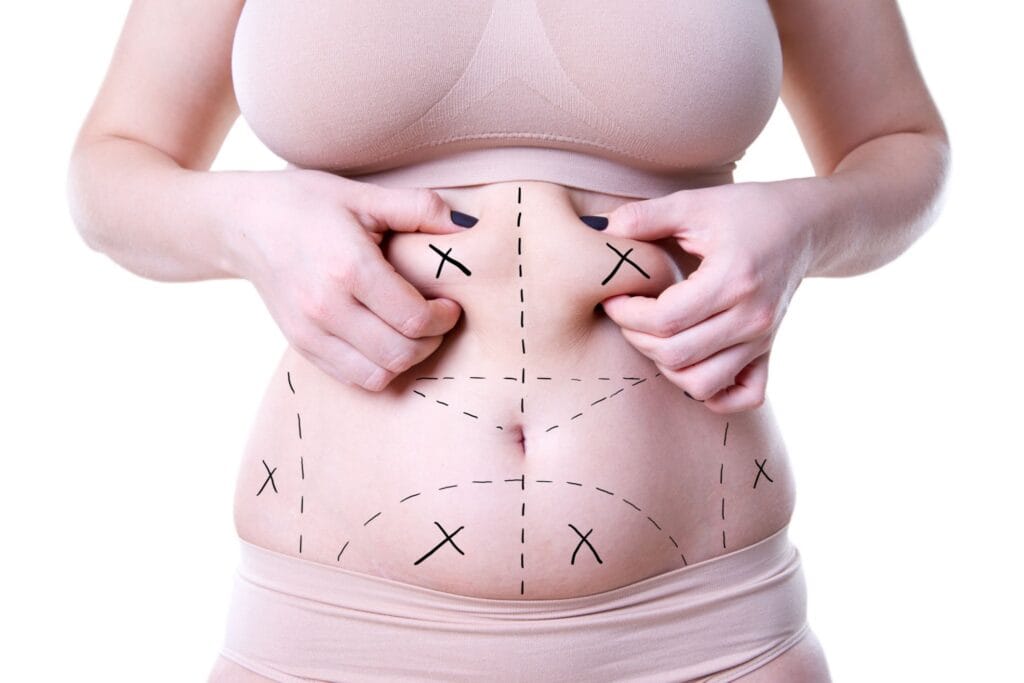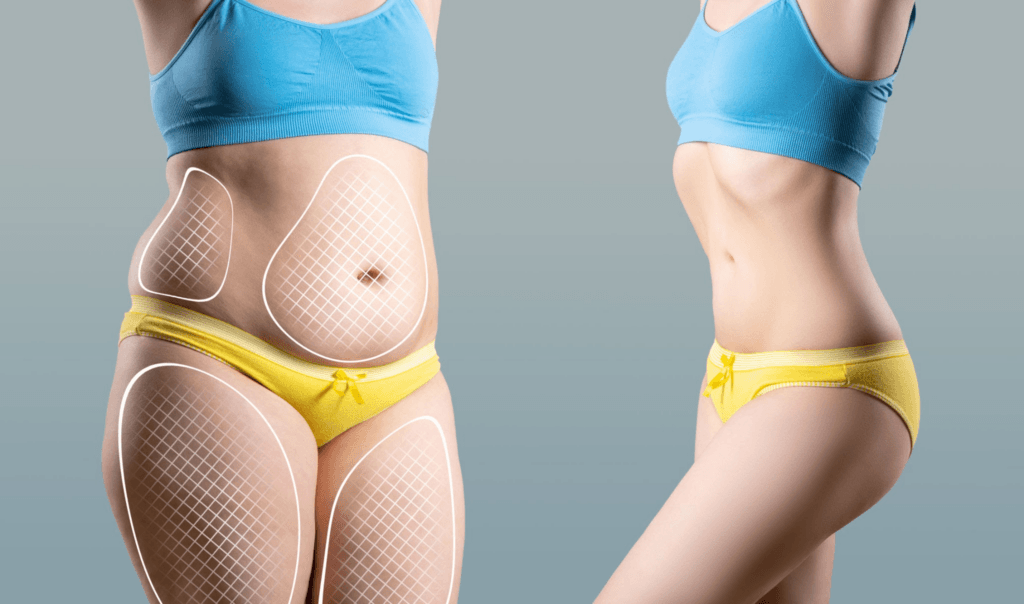In the realm of aesthetic medicine, body contouring procedures have become increasingly popular, offering solutions for individuals looking to refine their physiques. Among the most sought-after options are tummy tucks and liposuction. While both procedures aim to improve the body’s silhouette, they address different concerns and involve distinct surgical approaches. It’s common for people to confuse the two, or to think they are interchangeable, leading to misunderstandings about what each can achieve.
This comprehensive guide is designed to demystify these popular body contouring surgeries. We will delve deep into the specifics of both a tummy tuck (abdominoplasty) and liposuction, clarifying their fundamental differences, exploring the unique benefits each offers, and identifying the ideal candidates for each procedure. By the end of this article, you will have a clear understanding of which procedure might be best suited to your individual aesthetic goals.

Tabla de contenido
Understanding Body Contouring Procedures
Body contouring refers to a range of surgical and non-surgical procedures designed to reshape and improve the appearance of the body. These procedures are typically chosen after significant weight loss, pregnancy, or simply to address stubborn fat deposits and loose skin that don’t respond to diet and exercise.
▸ Definition and Purpose
Body contouring is an umbrella term for medical procedures that reshape the body. Its primary purpose is to enhance physical appearance by removing excess skin and fat, and in some cases, tightening underlying muscles. The goal is to achieve a more proportionate, toned, and aesthetically pleasing physique. It’s not a weight-loss solution but rather a refining process for individuals who are already at or near their ideal weight but struggle with specific areas.
▸ Common Reasons for Body Contouring
People opt for body contouring for a variety of reasons. One of the most common motivations is addressing loose or sagging skin that results from significant weight loss, which often leaves an apron of skin around the abdomen, arms, or thighs. Pregnancy can also lead to stretched abdominal muscles and excess skin, making a tummy tuck a popular choice for mothers. Furthermore, localized fat pockets that resist diet and exercise, often found on the abdomen, flanks, thighs, or arms, are a frequent reason for considering liposuction. Aging also plays a role, as skin elasticity naturally diminishes over time, contributing to sagging.
▸ Types of Body Contouring Procedures
Beyond tummy tucks and liposuction, the field of body contouring includes various other procedures. These can range from arm lifts (brachioplasty) to thigh lifts (thighplasty), body lifts (which address multiple areas simultaneously), and even breast lifts or reductions. Non-surgical options, such as cryolipolysis (fat freezing) or radiofrequency treatments, also fall under body contouring, offering less invasive alternatives for minor fat reduction and skin tightening. Each procedure is tailored to specific areas and concerns, highlighting the personalized nature of aesthetic surgery.
¿Qué es una abdominoplastia?
A tummy tuck, medically known as abdominoplasty, is a major surgical procedure designed to create a flatter, firmer abdominal profile. It addresses concerns that diet and exercise alone cannot resolve.
▸ Definition and Purpose
A tummy tuck is a cosmetic surgical procedure that removes excess skin and fat from the abdomen and tightens the abdominal wall muscles. Its primary purpose is to flatten the abdomen, reduce the appearance of stretch marks (especially those below the navel), and restore a more youthful and toned contour. It is particularly effective for individuals who have loose, sagging skin due to significant weight loss or pregnancy, as it directly addresses issues with both skin laxity and muscle separation (diastasis recti).
▸ Procedure Details
The standard tummy tuck procedure involves a horizontal incision made just above the pubic area, extending from hip to hip. A second incision may be made around the navel to free it from surrounding tissue. The surgeon then lifts the skin and fat, tightens the underlying abdominal muscles by suturing them together, and pulls the remaining skin downwards. Excess skin and fat are then removed, and a new opening for the belly button is created. The remaining skin is then redraped, and incisions are closed. There are variations, such as a mini tummy tuck for less extensive skin laxity below the navvel, and an extended tummy tuck for those who also need improvement in the flanks and lower back.
▸ Benefits
The benefits of a tummy tuck are significant and often transformative. Patients experience a flatter, firmer, and more toned abdomen, which can greatly improve clothing fit and body confidence. It effectively removes excess sagging skin, which can cause irritation or hygiene issues. For women post-pregnancy, it can repair separated abdominal muscles (diastasis recti), which not only improves appearance but can also alleviate lower back pain and improve core strength. While not a weight-loss procedure, removing excess skin and fat can result in a modest weight reduction. The results are generally long-lasting, provided the patient maintains a stable weight.
▸ Ideal Candidates
Ideal candidates for a tummy tuck are typically individuals who are in good general health, have a stable weight, and have realistic expectations about the outcome. They often have excess sagging skin and weakened abdominal muscles that have not responded to diet and exercise. This includes women who have experienced multiple pregnancies, individuals who have undergone significant weight loss, or those with genetic predisposition to loose skin in the abdominal area. It’s crucial for candidates to be non-smokers and free from medical conditions that could impair healing or increase surgical risks. A tummy tuck is not suitable for those looking for a quick weight loss solution.
▸ Recovery and Results
The recovery process for a tummy tuck is more extensive than for liposuction due to its invasive nature. Patients typically experience soreness, swelling, and bruising, and will need to wear a compression garment for several weeks to help reduce swelling and support the healing tissues. Drains may be placed temporarily to collect fluid. Most patients require 2-4 weeks off from work and should avoid strenuous activities for 6-8 weeks. Full results become apparent as swelling subsides over several months, with the final outcome often visible within 6-12 months. The scar, initially prominent, will fade over time but is permanent and typically well-concealed by underwear or swimwear.
¿Qué es la liposucción?
Liposuction is a surgical procedure designed to remove localized fat deposits that are resistant to diet and exercise, aiming to sculpt and recontour specific areas of the body.
▸ Definition and Purpose
Liposuction, often referred to simply as “lipo,” is a cosmetic procedure that suctions fat from specific areas of the body, such as the abdomen, hips, thighs, buttocks, arms, or neck. Its primary purpose is not weight loss but body sculpting and contouring. It’s designed for individuals who are at or near their ideal body weight but have isolated pockets of stubborn fat that don’t respond to traditional weight loss methods. Liposuction effectively reduces these localized fat bulges, creating a smoother and more proportionate body shape. It does not address loose skin or improve skin elasticity significantly.
▸ Procedure Details
Liposuction is typically performed using a thin, hollow tube called a cannula, which is inserted through small incisions in the skin. Before the fat is suctioned out, a sterile solution (tumescent fluid) – a mixture of saline, lidocaine (anesthetic), and epinephrine (to constrict blood vessels and reduce bleeding) – is usually injected into the fatty area. This makes fat removal easier, reduces blood loss, and provides local anesthesia. The cannula is then moved back and forth to break up the fat cells, which are then suctioned out using a vacuum pump or syringe. There are various techniques, including tumescent liposuction, ultrasound-assisted liposuction (UAL), and laser-assisted liposuction (LAL), each offering slightly different benefits in terms of fat liquefaction and skin tightening.
▸ Benefits
The main benefits of liposuction include a more contoured and streamlined appearance in targeted areas. It effectively removes stubborn fat pockets that have been resistant to diet and exercise, leading to an improved body proportion. Patients often experience an enhanced self-image and increased confidence. The procedure is less invasive than a tummy tuck, typically involving smaller incisions and a shorter recovery period. Results can be seen relatively quickly as swelling subsides, and the fat cells removed during liposuction are permanently gone, meaning that if weight is maintained, the results are long-lasting. It’s an excellent option for precise contouring rather than overall body reshaping.
▸ Ideal Candidates
Ideal candidates for liposuction are individuals who are close to their ideal body weight, have good skin elasticity, and have localized fat deposits that they wish to remove. They should be in good health, non-smokers, and have realistic expectations about the outcome. Liposuction is not a treatment for obesity or a substitute for a healthy lifestyle. It’s best for those who have a relatively stable weight and are looking to refine their body shape by targeting specific areas like love handles, saddlebags, or a double chin. Good skin elasticity is important because liposuction does not remove excess skin, and if the skin lacks elasticity, it may appear loose after fat removal.
▸ Recovery and Results
The recovery from liposuction is generally less involved than that of a tummy tuck. Patients typically experience bruising, swelling, and soreness in the treated areas. A compression garment is usually worn for several weeks to help reduce swelling and aid in skin retraction. Most patients can return to light activities and work within a few days to a week. Strenuous exercise should be avoided for 2-4 weeks. Initial results are often visible once the swelling begins to subside, which can take several weeks. The full results typically become apparent over several months as the body continues to heal and swell completely resolves, usually within 3-6 months. The small incisions heal well, often becoming barely noticeable over time.
Key Differences Between a Tummy Tuck and Liposuction
While both procedures aim to improve body contour, their fundamental differences lie in their approach, target areas, and the type of issues they resolve.
▸ Procedure Techniques
The most significant difference lies in the surgical techniques. A tummy tuck is an invasive surgical procedure that involves a large incision to remove excess skin and fat, and crucially, to tighten underlying abdominal muscles. It’s a reconstructive surgery for the abdominal wall. Liposuction, on the other hand, is a less invasive procedure that uses small incisions to insert a cannula and suction out localized fat deposits. It focuses purely on fat removal and does not address loose skin or muscle laxity.
▸ Target Areas
A tummy tuck primarily targets the abdomen, specifically addressing excess skin, fat, and weakened muscles in this region. While some fat may be removed, its main purpose is comprehensive abdominal reshaping. Liposuction can be performed on almost any area of the body where there are stubborn fat pockets, including the abdomen, flanks (love handles), hips, thighs, buttocks, arms, back, and neck. It’s ideal for isolated fat reduction rather than widespread skin removal.
▸ Results and Outcomes
The results of a tummy tuck are a dramatically flatter and firmer abdomen, often with a tighter waistline, and the removal of skin folds and stretch marks below the navel. It provides a more comprehensive rejuvenation of the abdominal area. Liposuction results in a reduction of localized fat bulges and improved body contours in the treated areas. While it can make an area smaller and more sculpted, it won’t resolve sagging skin or repair muscle separation. For instance, a person with significant loose abdominal skin will not achieve a flat stomach with liposuction alone.
▸ Recovery and Downtime
Due to the more extensive nature of a tummy tuck, the recovery period is significantly longer and more demanding. Patients often experience more pain, swelling, and bruising, and typically require 2-4 weeks off work and 6-8 weeks before resuming strenuous activities. Liposuction has a shorter and generally easier recovery, with most patients returning to light activities within a few days and full activities within 2-4 weeks. The discomfort associated with liposuction is usually less severe, often described as muscle soreness.
▸ Cost Considerations
Generally, a tummy tuck is a more expensive procedure than liposuction because it is a more complex and time-consuming surgery requiring general anesthesia, longer operating room time, and extensive post-operative care. The cost of a tummy tuck can range from $8,000 to $15,000 or more, depending on the surgeon’s fees, anesthesia fees, facility costs, and geographical location. Liposuction costs vary widely depending on the number and size of areas treated, but typically range from $2,500 to $8,000 per area. It’s important to obtain a detailed quote from a qualified surgeon as prices can fluctuate significantly.

Conclusión
Understanding the distinct differences between a tummy tuck and liposuction is crucial for anyone considering body contouring. While both procedures aim to enhance your physique, they address entirely different sets of concerns. A tummy tuck is a comprehensive abdominal rejuvenation surgery, ideal for those with significant loose skin and weakened abdominal muscles, often after pregnancy or major weight loss. It results in a dramatically flatter, firmer abdomen and can remove stretch marks. Liposuction, on the other hand, is a targeted fat removal procedure, best suited for individuals with good skin elasticity who wish to eliminate stubborn, localized fat pockets that resist diet and exercise. It sculpts specific areas of the body but does not tighten skin or muscles.
The choice between these two powerful procedures is deeply personal and depends entirely on your specific body concerns, aesthetic goals, and overall health. It’s not about choosing the “better” procedure, but rather the “right” procedure for you. This decision should never be made lightly or without expert guidance. The most critical step in your journey toward a more confident you is to schedule a consultation with a qualified and board-certified plastic surgeon.
During this consultation, your surgeon will evaluate your unique anatomy, discuss your medical history, listen to your goals, and provide personalized recommendations. They can explain the risks and benefits in detail, show you before-and-after photos, and help you set realistic expectations for the outcome. An informed decision, made in collaboration with a skilled professional, is the cornerstone of a successful and satisfying body contouring experience.
▸ Key Takeaways
- Tummy Tuck (Abdominoplasty): Removes excess skin and fat from the abdomen, and tightens weakened abdominal muscles. Ideal for post-pregnancy or significant weight loss.
- Liposucción: Suctions out localized fat deposits to contour specific areas of the body. Best for stubborn fat pockets where skin elasticity is good.
- Skin and Muscle vs. Fat Only: A tummy tuck addresses loose skin and muscle separation; liposuction only removes fat.
- Recovery and Cost: Tummy tuck has a longer, more involved recovery and is generally more expensive than liposuction.
Preguntas frecuentes
▸ Who is an ideal candidate for a tummy tuck?
An ideal candidate for a tummy tuck is an individual who has significant excess skin and/or weakened abdominal muscles, often due to pregnancy, massive weight loss, or aging. They should be in good general health, a non-smoker, have a stable weight, and hold realistic expectations about the procedure’s outcomes. It is not a weight-loss surgery, so candidates should be close to their ideal body weight.
▸ Who is an ideal candidate for liposuction?
An ideal candidate for liposuction is someone who is at or near their ideal body weight but struggles with localized pockets of stubborn fat that haven’t responded to diet and exercise. They should have good skin elasticity, be in good overall health, and have realistic expectations. Liposuction is not a solution for obesity or a replacement for healthy lifestyle habits.
▸ How long is the recovery period for a tummy tuck?
The recovery period for a tummy tuck is typically 2-4 weeks for returning to light activities and desk work. Strenuous exercise and heavy lifting should be avoided for 6-8 weeks. Full recovery and the final results can take 6-12 months as swelling completely resolves. Patients usually wear a compression garment for several weeks to months.
▸ How long is the recovery period for liposuction?
The recovery period for liposuction is generally shorter. Most patients can return to light daily activities within a few days to one week. Swelling and bruising are common and may last for several weeks. Strenuous exercise should be avoided for 2-4 weeks. A compression garment is usually recommended for several weeks. Final results are often visible within 3-6 months.
▸ Can liposuction and a tummy tuck be performed together?
Yes, it is common for liposuction and a tummy tuck to be performed together. This combined procedure, sometimes referred to as a “Lipoabdominoplasty,” allows the surgeon to remove excess skin and tighten muscles (tummy tuck) while simultaneously refining adjacent areas by removing stubborn fat (liposuction), such as the flanks or hips. Combining procedures can offer a more comprehensive body contouring result and may reduce overall downtime compared to undergoing two separate surgeries, though it does increase the total surgical time and complexity.
▸ What are the risks associated with a tummy tuck?
As with any major surgery, a tummy tuck carries potential risks, including infection, bleeding, adverse reaction to anesthesia, fluid accumulation (seroma), poor wound healing, numbness or changes in skin sensation, and unfavorable scarring. While serious complications are rare, it’s crucial to discuss all potential risks thoroughly with your surgeon before the procedure.
▸ What are the risks associated with liposuction?
Risks associated with liposuction include bruising, swelling, numbness, contour irregularities (uneven skin), infection, fluid accumulation (seroma), skin discoloration, and adverse reactions to anesthesia. Serious complications like fat embolism or perforation are extremely rare but possible. Choosing a board-certified plastic surgeon can significantly minimize these risks.
▸ How much does a tummy tuck cost on average?
The average cost of a tummy tuck typically ranges from $8,000 to $15,000. However, this is just an estimate. The final cost can vary significantly based on factors such as the surgeon’s fees, anesthesia fees, operating room facility costs, the extent of the procedure (mini vs. full tummy tuck), and geographical location. It’s important to note that these costs generally do not include pre- or post-operative care, prescriptions, or medical tests.
▸ How much does liposuction cost on average?
The average cost of liposuction can range from $2,500 to $8,000 per area treated. The total cost depends on several factors, including the size and number of areas being treated, the amount of fat removed, the type of liposuction technique used, the surgeon’s fees, anesthesia fees, and facility costs. Similar to a tummy tuck, these figures are averages and the actual cost will be determined during your consultation.
▸ How do I choose the right surgeon for my procedure?
Choosing the right plastic surgeon is paramount for a safe and successful outcome. Look for a surgeon who is board-certified by the American Board of Plastic Surgery (or equivalent in your country), ensuring they have met rigorous standards of training and ethics. Verify their experience with tummy tucks and liposuction specifically. Review before-and-after photos of their previous patients, and read patient testimonials. Ensure the surgeon operates in an accredited surgical facility. During your consultation, evaluate their communication style, whether they answer all your questions thoroughly, and if you feel comfortable and confident in their care. A reputable surgeon will prioritize your safety and provide realistic expectations.
Nuestros cirujanos y profesionales afiliados
At Surgyteam, we are proud to collaborate with a distinguished team of medical professionals, each bringing a wealth of expertise and a commitment to patient-centered care.
- Dr. Mehmet Fatih Okyay (Dr. MFO): Plastic, Reconstructive and Aesthetic Surgery Specialist. Co-founder of Surgyteam. FEBOPRAS certified. (https://www.dr-mfo.com/)
- Dr. Selçuk Yılmaz: Plastic, Reconstructive and Aesthetic Surgery Specialist. (https://drselcukyilmaz.com)
- Dr. Ebru Okyay: Dermatology Specialist. (https://drebruokyay.com/)
- Dr. Mustafa Keleş: Aesthetic, Plastic and Reconstructive Surgery Specialist. (https://www.medstar.com.tr/doktorlar/mustafa-keles/)
- Dr. Boray Yücel: Plastic, Reconstructive and Aesthetic Surgery Specialist. (https://borayucel.com/)
- Dr. Sibel Atalay: Plastic, Reconstructive and Aesthetic Surgery Specialist. Clinic with International Health Tourism Authorization Certificate. (https://www.sibelatalay.com.tr/)
- Dr. Mert Meral: Plastic, Reconstructive and Aesthetic Surgery Specialist. EBOPRAS certified. (https://mertmeral.com/)
To learn more about Surgyteam and how we can assist you, please visit our website:
https://surgyteam.com/
Disclaimer: This blog post is intended for informational purposes only and does not constitute medical advice. Costs are estimates and can vary. Always consult with a qualified medical professional for personalized advice and treatment.



